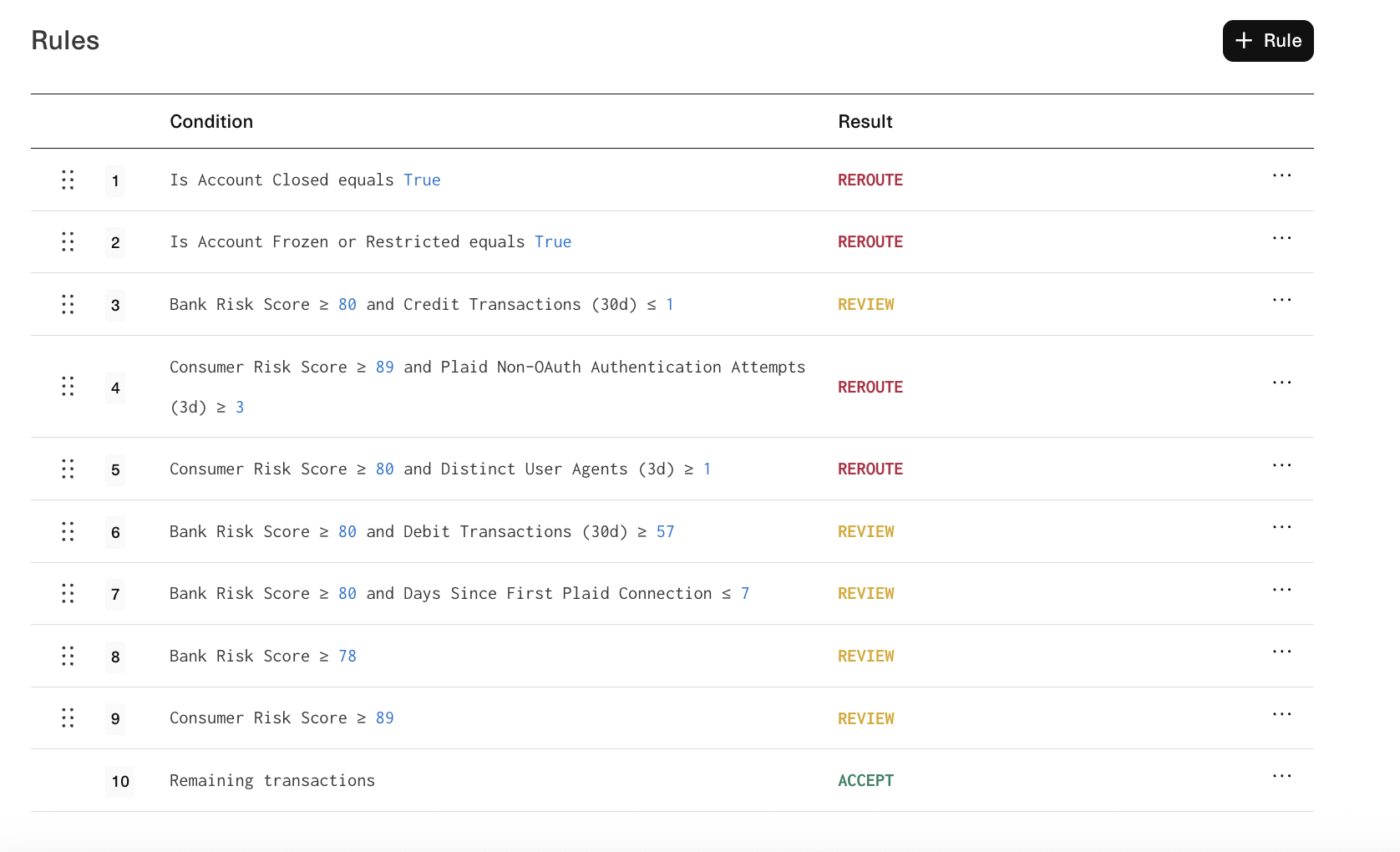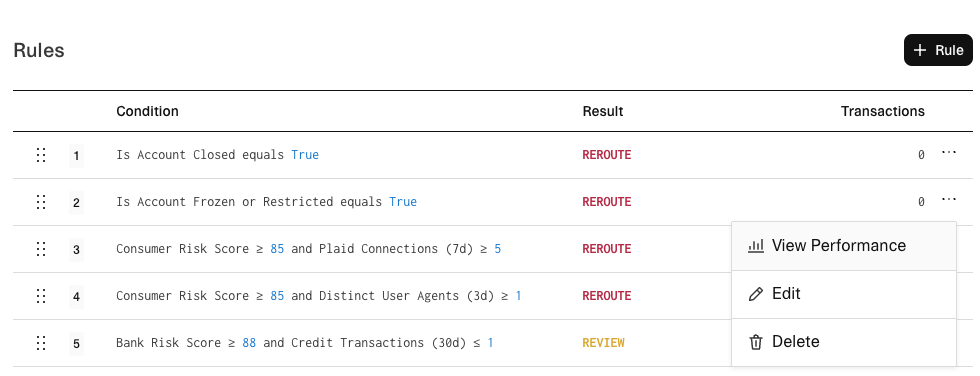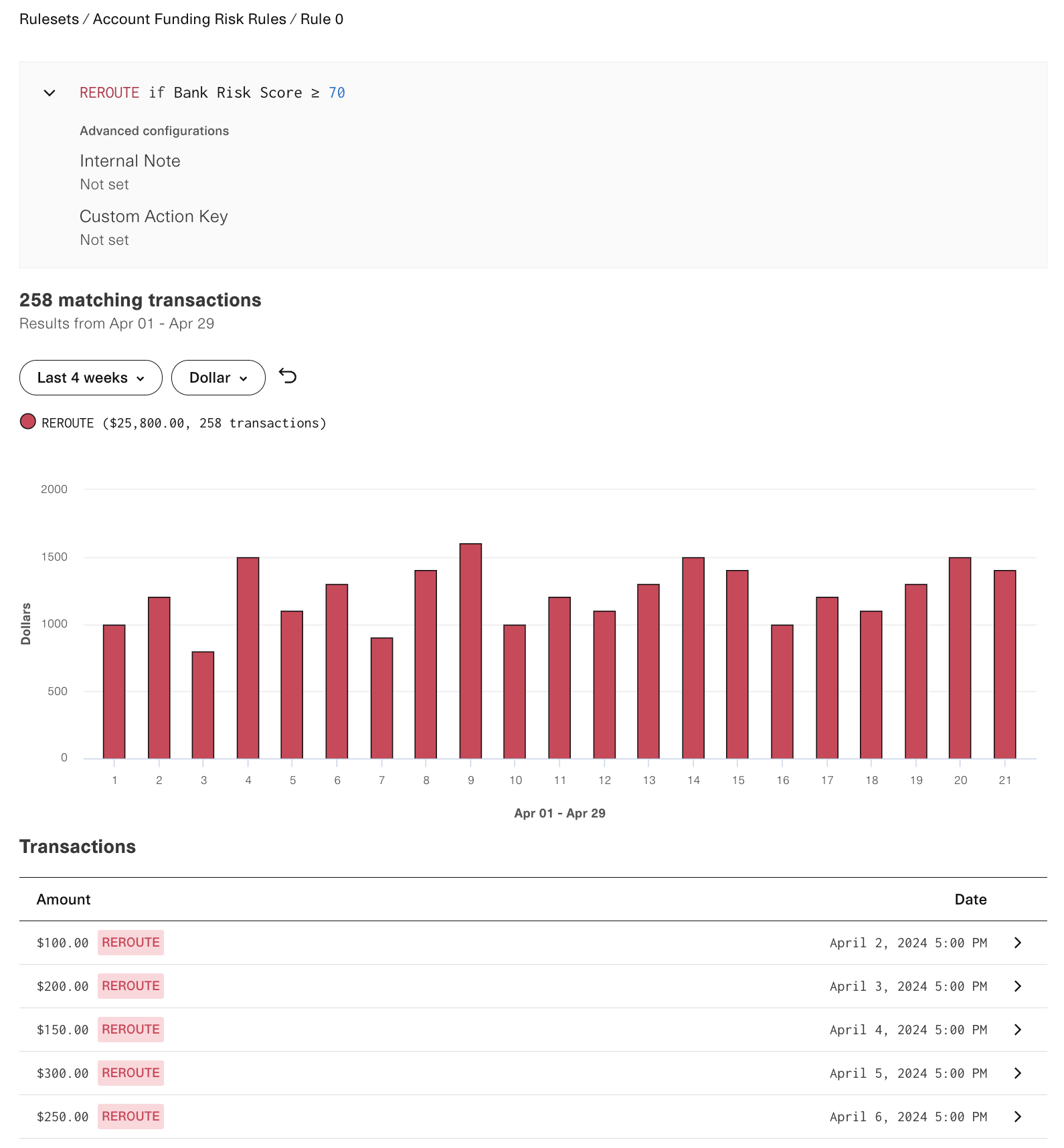Signal Rules
Learn about configuring Signal Rules
Using Signal Rules
With Signal Rules, you can configure your decision logic directly within the Signal Dashboard using templates from Plaid, then use Dashboard tools to tailor the rules to your own traffic.
Signal Rules are available to users of both Signal Transaction Scores and Balance products.
Rules can be based on scores (higher scores indicate higher risk), attributes of the transaction, or a combination.
You can set up the following actions for your business to take as a result of a rule:
ACCEPTand process the transactionREVIEWthe transaction further before processingREROUTEthe customer to another payment method, as the transaction is too risky
You can also create more complex action flows through the use of custom action keys.
You can define a single ruleset for all your transactions, or you can build use-case specific rulesets, such as one for an initial deposit during customer onboarding and another for a returning customer depositing funds.
Creating a ruleset
Before using Signal Rules, you must create a Ruleset in the Dashboard, under Signal > Rules. You can create a ruleset from scratch, or Plaid can suggest an initial ruleset template relevant for your use case by utilizing context collected during your onboarding (such as transaction size).
Rules are evaluated sequentially, from top to bottom, typically ordered by the severity of the rule violation. If data that the rule depends on is not available, the rule will be skipped.
The result of the first rule that matches will be applied to the transaction and included in the /signal/evaluate response. You will be required to have a fallback rule that is applied if no other rules match.

Signal Transaction Score versus Balance-only rulesets
When creating a ruleset, you will be given the choice between creating a Signal Transaction Score or Balance-only ruleset.

Balance customers who are not enabled for Signal Transaction Scores can create only Balance-only rulesets.
/signal/evaluate calls that use a Signal Transaction Score ruleset:
- Return the full
core_attributesarray with all 80+ core attributes, all of which can be used in the rule configuration - Have ultra-low latency (p95 <2s)
- May use cached data
- Will not perform a real-time balance extraction
- Will be billed as Signal Transaction Score calls
- Are available only to Signal Transaction Scores customers
/signal/evaluate calls that use a Balance-only ruleset:
- Return only two
core_attributes:available_balanceandcurrent_balance, which can be used in the rule configuration - Have higher latency (p95 ~11s)
- Always perform a real-time fresh balance extraction
- Will be billed as Balance calls
- Are available to all customers on the Plaid Signal platform, including Balance-only customers
Using Signal Ruleset results
To evaluate a transaction's risk, call /signal/evaluate and include the required request properties in addition to the ruleset's ruleset_key, which can be found in the Dashboard, in smaller type under the name of the ruleset.
The more properties you provide when calling /signal/evaluate, such as the user or device fields, the more accurate the results will be. Providing the client_user_id is also recommended to aid in your debugging process later.
In the response, use the ruleset.result property to determine the next steps.
Most integrations use the result to decide between approving a payment for processing (result=APPROVE), or rerouting the consumer to another payment method (result=REROUTE). If that's the case with your integration, ensure that your ruleset emits only these two result types.
If your integration is taking more complex actions before deciding whether to process the transaction (for example, sending certain transactions to a manual review queue), use the REVIEW result type. Remember to report the final decision for these reviewed transactions later.
Signal Transaction Score results can never be used as an input to determine a consumer's eligibility to access your services. Signal Transaction Scores evaluates the risk of a transaction from a specific bank account and can be used to determine if you should require the user to use a different payment method, according to your risk tolerance.
Opting out of the default ruleset
If you do not specify a ruleset_key, your default ruleset will be used. If you do not have a default ruleset and the ruleset_key is not specified, /signal/evaluate will return an error unless you have opted out of the default ruleset. If you omit the ruleset_key and have opted out of the default ruleset, /signal/evaluate will return core_attributes but will not return a ruleset or a ruleset.result.
All customers who were enabled for Signal Transaction Scores in Production before October 15, 2025, are automatically opted out of the default ruleset, in order to maintain parity with earlier behavior (before ruleset functionality was introduced).
Signal Transaction Scores customers who use /signal/evaluate exclusively to incorporate raw insights from the core_attributes into their own risk models, and do not want to use Signal rulesets at all, can choose to opt out of the default ruleset by contacting their Account Manager. For more details on using Signal Transaction Scores in this mode, see Accessing scores and attributes directly via API.
Opting out of the default ruleset only impacts behavior when no ruleset is specified in the /signal/evaluate call; if you explicitly specify a ruleset when calling /signal/evaluate, the ruleset will be used.
Balance-only customers cannot opt out of the default ruleset. If you wish to check real-time balance without a ruleset, use /accounts/balance/get instead of /signal/evaluate.
To re-enable using default rulesets, contact your Account Manager.
For existing customers prior to May 2025: Migrating away from the outcome field
Customers who used Signal Rules before May 2025 used the ruleset.outcome field. This field has been replaced by ruleset.result. Update your integration to use the new values from the ruleset.result field:
| Outcome (old) | Result (new) |
|---|---|
block | REROUTE |
accept | ACCEPT |
review | REVIEW |
For most integrations, that's all you need to change. Once you've updated your integration, inform your account manager.
If you have an advanced use case where you take different actions for transactions with the same result, you can use the custom_action_key. For example, to apply a variable hold time, make sure your Signal rules emit an result=ACCEPT value for all transactions you intend to process. Then, use the custom_action_key to define a 3-day-hold for some rules and 5-day-hold for others. For more details, see Using a custom action key.
Using a custom action key for advanced actions
Some integrations may need more options for handling a transaction than the three choices of ACCEPT, REVIEW, or REROUTE. Common use cases include:
- Applying a variable hold time to transactions that were accepted and processed, depending on the level of risk.
- Applying labeling to transactions to denote a cohort for data analysis purposes.
- Running a Signal Transaction Score ruleset check on a proposed transaction, and falling back to a higher-latency, Balance-only ruleset check if the transaction is higher risk.
To support more complex actions, check the "Configure advanced options" box on the ruleset editing screen and specify a custom_action_key.
You can then create multiple rules with the same result but different custom actions. For example:
If medium risk,
ACCEPTwithcustom_action_key=5-day-holdIf low risk,
ACCEPTwithcustom_action_key=3-day-hold
When calling /signal/evaluate, use the custom_action_key in the response to determine the action to take.
Data availability limitations
The amount of consumer-permissioned data available can vary. Plaid attempts to prefetch this data at a regular cadence and will also attempt to fetch fresh data during the /signal/evaluate call if needed. Most Signal Transaction Score evaluations will return information about the Item's use in the network, the latest balance, historical balance information, or account activity. The full set of data is usually available to Plaid within 15 seconds of Plaid Link being completed. However, partial data may be returned if /signal/evaluate is called before this process completes, the Item has been inactive for a long time, or the financial institution's connectivity to Plaid is degraded or down.
When used with Items that do not have a connection to a financial institution, (i.e., Items created verified using alternative methods such as micro-deposits or Database Auth), Plaid can generate Signal Transaction Scores for approximately 30% of these Items, although Items created in this way will have no data in the core_attributes response property. If there is insufficient data, the scores property will be null, and any rules using score will be skipped (potentially triggering your fallback rule). You will still be billed for the evaluation (unless you have no Signal Ruleset enabled).
Testing Signal Rules in Sandbox
In the Sandbox environment, scores and attributes returned by /signal/evaluate will be randomly generated. You can influence the score returned by /signal/evaluate in Sandbox by providing particular values in the amount request field. Use the values from the following table to control the returned score:
| Amount | Score |
|---|---|
| 3.53 | 10 |
| 12.17 | 60 |
| 27.53 | 90 |
You can use these hardcoded responses and create simple rules in Sandbox (such as REROUTE if bank_score == 90) to test various result types.
Debugging transactions
All evaluations can be viewed in realtime on the transactions viewer Dashboard page. Look up your transaction using its client_transaction_id. You can see its scores, the ruleset's result, and the data used to build the score.
Debugging rules
You can view all transactions that matched a specific rule by clicking View Performance in the ... icon on the rule.


Tuning your rules
After your integration is live, Plaid will report metrics such as approval rate, and ACH return rate, in the Signal Dashboard. You will use these Dashboard tools to tune your rule logic, which is a critical step in a successful launch.
You must integrate the /signal/return/report endpoint to use the Plaid Dashboard performance data features. If you do not report returns, performance data will not be available.
Shadow tests and proof of concept testing
If you're using Signal as part of a shadow test or proof of concept, you should still follow all the of the above integration guidance as though you were launching to production (including use of Signal Rules) - you just won't use the results to make the real-world payment decision. Log any relevant rule results, scores, or attributes as necessary.
It is particularly critical to report decisions and returns in shadows and proof of concepts, in order for Plaid to measure performance and provide optimized rule suggestions tailored to your traffic.
Accessing scores and attributes directly via API
Plaid strongly recommends using Signal Rules. However, if you have your own risk management system in which you are using Signal Transaction Scores as one of multiple data sources, you might choose to ingest this data directly via the API instead. You can also ingest this data directly via the API while using Signal Rules as well. If you don't use Signal Rules, Plaid may be limited in the support it can offer you in tuning external logic.
To directly access scores and data attributes, call /signal/evaluate. The scores and core_attributes properties in the response will contain the raw data you can provide to your model. For a full listing of core_attributes, contact your Account Manager. If you are not using Signal Rules, you should also contact your Account Manager to opt out of the default ruleset.
Even if you aren't using Signal Rules, it's still recommended to report decisions and returns in order to use the Signal Performance pane, which helps you understand performance and find the right score threshold.
For Reseller Partners
A reseller partner will have a global ruleset that all their end customers inherit. If the reseller makes a change to that global default ruleset, all the end-customers also automatically adopt that change as well. End customers can also create their own rulesets, which will not propagate back to the reseller partner.